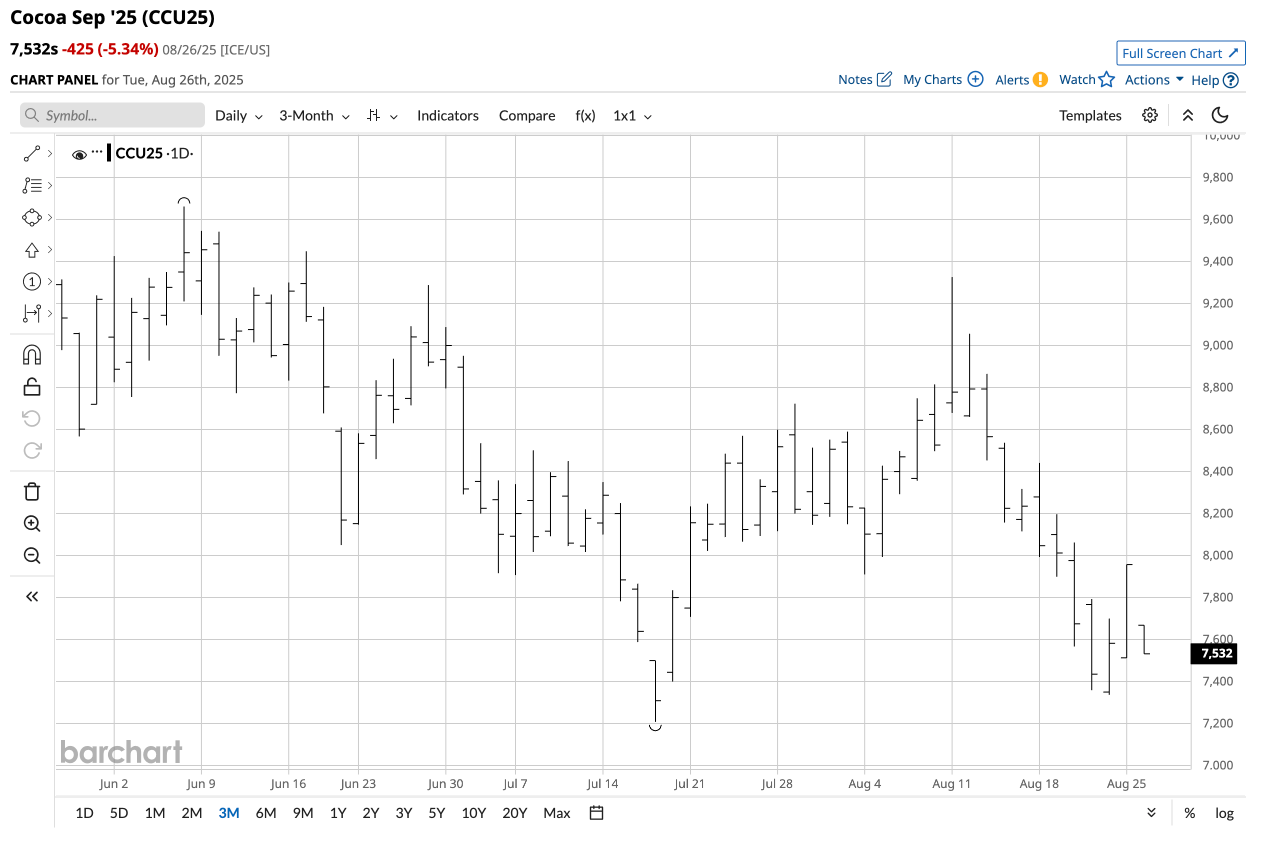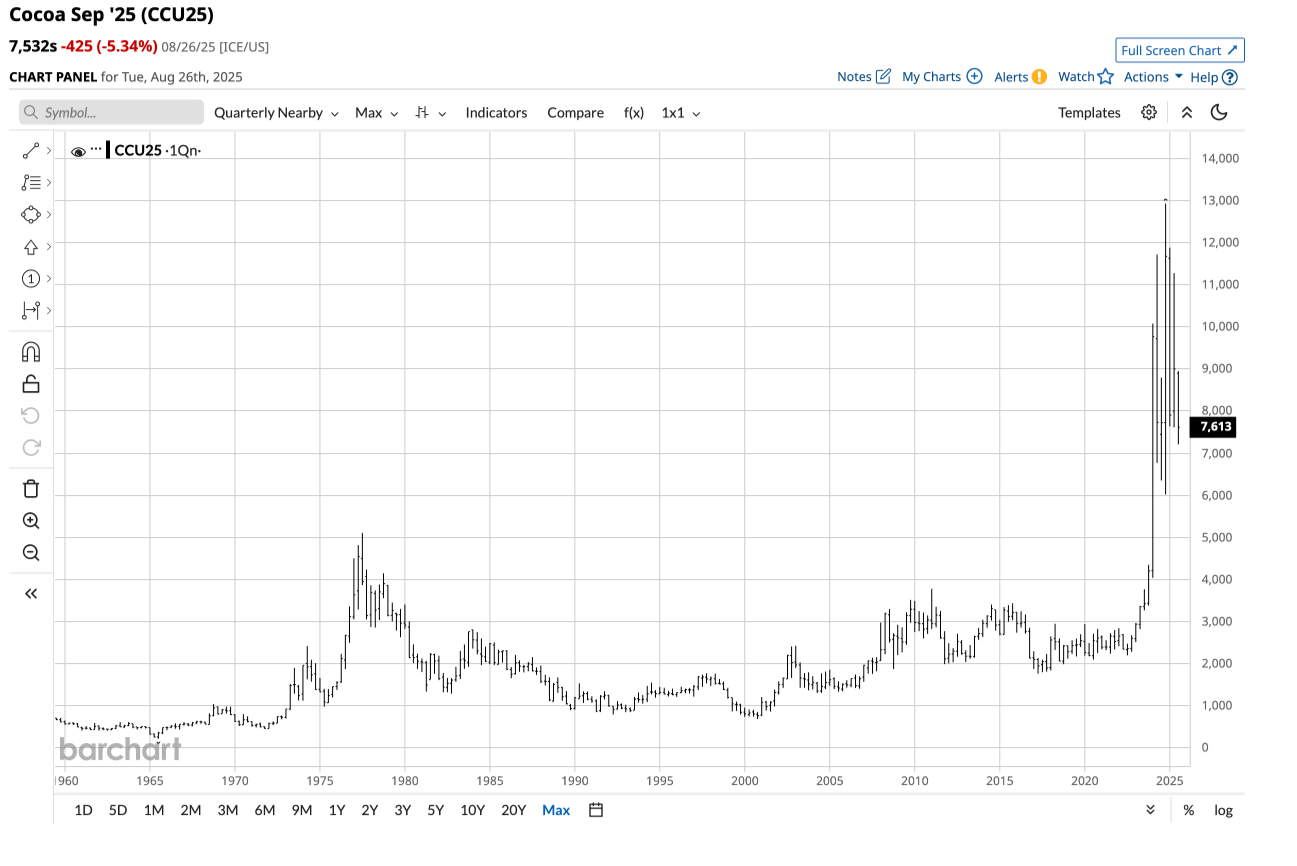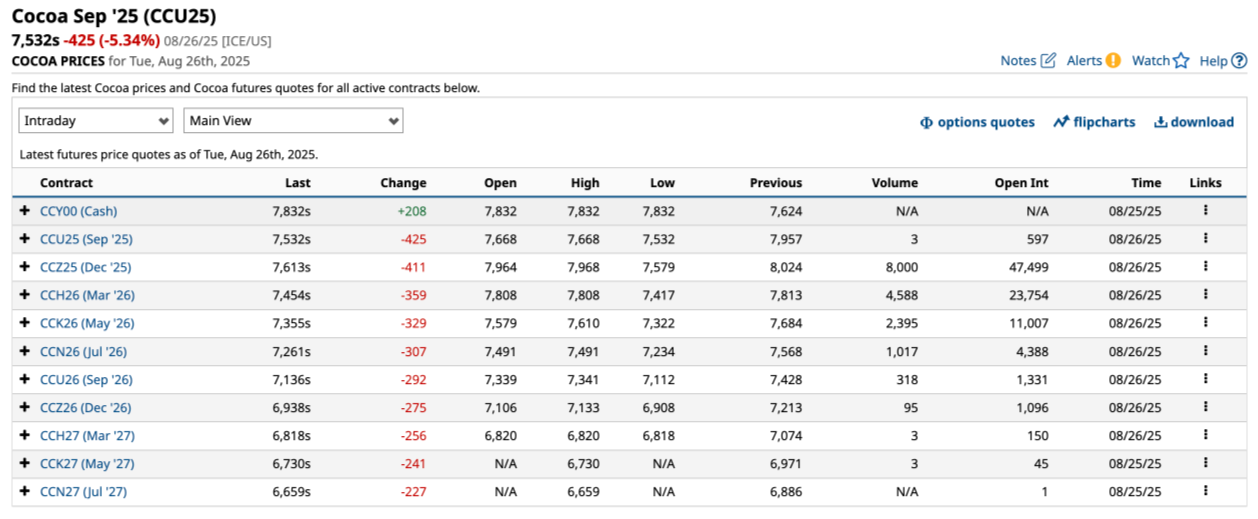Is Cocoa Heading Back to the Recent High?
Nearby ICE cocoa futures were trading at $10,904 per ton on May 19 and had fallen to $8,047 by late August. My Q2 2025 Barchart article on soft commodities highlighted that cocoa futures rose 18.4% in Q2 but were 19.86% lower over the first six months of 2025. Nearby cocoa futures settled at $9,356 per ton on June 30.
While cocoa futures have slumped in 2025, they have declined from a lofty level. With prices above the 1977 high and ongoing West African supply issues persisting, the potential for another rally remains high.
Cocoa falls, but the price is consolidating
Nearby ICE cocoa futures for September 2025 delivery have moved lower since the end of the second quarter.

The daily chart highlights the 16.3% decline from $9,000 on June 30, 2025, to $7,532 per ton on August 26, 2025. While cocoa prices have dropped since the end of the second quarter, the soft commodity has remained relatively stable, consolidating between the July 17 low of $7,208 and the August 11 high of $9,326 per ton during the first half of the third quarter. At $7,532, cocoa futures were below the midpoint of the consolidation range and not far above the low.
The state of cocoa supplies in late August 2025
While the International Cocoa Organization had forecast a 240,000-ton global surplus for 2024/2025, the forecast followed on the heels of a historic deficit; supply risks have supported cocoa futures prices. West African weather, crop diseases, and aging cocoa plants have experienced reduced cocoa bean yields. Political tensions between the two primary producers, the Ivory Coast and Ghana, have added to the uncertainty. Meanwhile, cocoa inventories in the Ivory Coast and Ghana remain near the lowest levels in a decade after erratic rainfall and weather conditions delayed pollination of the 2023/1014 crop. The bottom line is that while the supply conditions have improved, supply uncertainty continues to keep prices above the pre-2024 record high.
The long-term trend remains higher
The long-term quarterly chart shows that cocoa prices have remained at the highest level in history.

The chart shows that before 2024, the ICE cocoa futures record high was in 1977 at $5,104 per ton. After reaching a Q4 2024 record high of $12,931 per ton, cocoa fell to the July 2025 low of $7,208 per ton, holding over $2,100 above the high from 1977 and the critical long-term technical support level.
The other factors supporting cocoa prices
Other factors that support higher cocoa prices are:
- A weaker U.S. dollar tends to be bullish for commodity prices. The U.S. dollar index fell from over 110 in January 2025 to the 98 level in mid-August 2025.
- Elevated global inflation increases production costs, which in turn supports most commodity prices.
- U.S. tariffs have distorted the prices of many raw materials. The U.S. has imposed tariffs on the Ivory Coast and Ghana, countries that account for over 70% of the world’s annual cocoa bean output. Higher tariffs increase prices.
- Since cocoa broke out above the 1977 high in 2024, the price has remained above the $5,104 level and in a bullish long-term trend. The trend is always a trader or investor’s best friend.
Commodity cyclicality suggests that the cure for cocoa’s high price is its price as producers will increase output, inventories will increase as consumers curtail buying, and the price will establish a top. While it is possible that the December 2024 high of $12,931 per ton is a top, the price has not returned to challenge the technical support at $5,104 per ton. The bottom line is that weather conditions, crop diseases, and political factors in West Africa will dictate the path of least resistance of cocoa futures prices over the coming days, weeks, and months. The current environment suggests elevated prices above the technical support into 2026, leading to buying opportunities on substantial price weakness.
Futures are the only way to participate- The forward curve suggests commodity cyclicality
Cocoa’s forward curve highlights the current backwardation, where deferred prices are mostly lower than prices for nearby delivery.

The forward cocoa curve indicates that prices for cocoa in July 2027 are $873 per ton lower than those for the September contract. However, the 2027 prices remain above the high from 1977, which is the critical technical support level. While the forward curve suggests some commodity cyclicality, it indicates persistently elevated prices over the coming months and years.
The only way to participate in the cocoa market is through the Intercontinental Exchange’s futures and futures options. Each ICE cocoa futures contract contains 10 metric tons. At $7,532 per ton, the contract value is $75,320. The ICE exchange requires an original margin of $11,044 per contract, meaning a market participant can control $75,320 worth of cocoa futures on the long or short side for a 14.7% good faith deposit. If market differences lead to a decline in equity below $10,040 per contract, the exchange requires maintenance margin payments. The margin levels reflect cocoa volatility, so they can fluctuate higher or lower depending on the price variance of the volatile commodity.
Cocoa has been extremely volatile, and while it remains in a long-term bullish trend at the $7,532 per ton level, support at the July 17 low of $7,208 is only 4.3% below the current price, with resistance 17.9% higher than the August 11 high of $8,883 per ton. Expect continued volatility in the cocoa futures market. While volatility creates trading opportunities, the risk in the cocoa market remains at an elevated level, so careful attention to risk-reward dynamics is critical when considering any risk position in the soft commodity.




